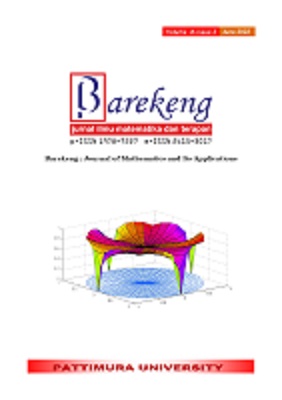INFLATION FORECASTS IN AMBON USING NEURAL NETWORK APPLICATIONS BACKPROPAGATION
Abstract
An artificial Neural Network is the processing of information systems on certain characteristics which are artificial representations based on human neural networks. Artificial Neural Networks can be applied to various fields in human life, one of which is the economic field. In this study, the Artificial Neural Network is used to predict the inflation rate using the Backpropagation method. The data used in this study is 144 data, with 100 data as training data and 44 data as test data taken from the Central Statistics Agency of Maluku Province from 2008-2019. The best prediction accuracy level is obtained by using learning rate (a) = 0.1, Target Error = 0.000001, Maximum epoch = 500, network architecture 11-1, and 70% training data sharing scheme and 30% test data. The average absolute error percentage (MAPE) is 85.21%.
Downloads
References
Ika Rinawati and Hari Basuki, “Analisis Perbandingan Makro Ekonomi Pemikiran Cendekiawan Muslim Klasik dan Kontemporer Abu Yusuf, Abu Ubaid, Yahya bin Adam, dan M.A Mannan, M. Umar Chapra,” vol. 2, pp. 21–36, 2020.
U. Kalsum, “Pengaruh Pengangguran Dan Inflasi Terhadap Pertumbuhan Ekonomi Di Sumatera Utara,” Ekon. J. Ilmu Ekon. dan Stud. Pembang., vol. 17, no. 1, pp. 87–94, 2017, doi: 10.30596/ekonomikawan.v17i1.1183.
F. I. Ali and I. Hidayat, “Pengaruh Kinerja Keuangan, Inflasi, dan Nilai Tukar Terhadap Harga Saham Pada Perusahaan Rokok,” J. Ilmu dan Ris. Manaj., vol. 5, no. 1, 2016.
BPS, No Title. Maluku, 2019.
J. M. Fakultas, “Prediksi Laju Inflasi di Kota Ambon Menggunakan Metode ARIMA Box Jenkins FERRY KONDO LEMBANG,” 2016.
Z. A. Leleury, Y. A. Lesnussa, and J. Madiuw, “Sistem Diagnosa Penyakit Dalam dengan Menggunakan Jaringan Saraf Tiruan Metode Backpropagation dan Learning Vector Quantization,” J. Mat. Integr., vol. 12, no. 2, p. 89, Jul. 2017, doi: 10.24198/jmi.v12.n2.11925.89-98.
D. Hakim Tanjung, “Jaringan Saraf Tiruan dengan Backpropagation untuk Memprediksi Penyakit Asma”.
M. F. Andrijasa and D. Mistianingsih, “Penerapan Jaringan Syaraf Tiruan Untuk Memprediksi Jumlah Pengangguran di Provinsi Kalimantan Timur Dengan Menggunakan Algoritma Pembelajaran Backpropagation,” 2010.
D. I. Rumah, S. Mardi, and R. Kudus, “Aplikasi Jaringan Saraf Tiruan Backpropagation Untuk Memprediksi Penyakit Tht Di Rumah Sakit Mardi Rahayu Kudus,” J. Tek. Elektro, vol. 1, no. 1, p. 11, 2009.
M. Andrijasa et al., “Penerapan Jaringan Syaraf Tiruan Untuk Memprediksi Jumlah Pengangguran di Provinsi Kalimantan Timur Dengan Menggunakan Algoritma Pembelajaran Backpropagation,” J. Inform. Mulawarman, vol. 5, no. 1, 2010.
D. T. Novi Indah Pradasar, F.Trias Pontia W, “Aplikasi Jaringan Syaraf Tiruan Untuk Memprediksi Penyakit Saluran Pernafasan Dengan Metode Backpropagation,” J. Coding Sist. Komput. Univ. Tanjungpura, vol. 01, no. 1, pp. 20–30, 2013.
D. L. Rahakbauw, F. Tahya, and M. Sopaheluwakan, “Prosiding Seminar Nasional Pendidikan Matematika Universitas Pattimura | Agustus,” 2019.
T. Brian, “ANALISIS LEARNING RATES PADA ALGORITMA BACKPROPAGATION UNTUK KLASIFIKASI PENYAKIT DIABETES,” 2016.
M. Azman Maricar, “Analisa Perbandingan Nilai Akurasi Moving Average dan Exponential Smoothing untuk Sistem Peramalan Pendapatan pada Perusahaan XYZ”.
I. Sungkawa, ; Ries, and T. Megasari, “PENERAPAN UKURAN KETEPATAN NILAI RAMALAN DATA DERET WAKTU DALAM SELEKSI MODEL PERAMALAN VOLUME PENJUALAN PT SATRIAMANDIRI CITRAMULIA,” 2011.
D. A. Nasution, H. H. Khotimah, and N. Chamidah, “Perbandingan Normalisasi Data untuk Klasifikasi Wine Menggunakan Algoritma K-NN,” Comput. Eng. Sci. Syst. J., vol. 4, no. 1, p. 78, 2019, doi: 10.24114/cess.v4i1.11458.
Authors who publish with this Journal agree to the following terms:
- Author retain copyright and grant the journal right of first publication with the work simultaneously licensed under a creative commons attribution license that allow others to share the work within an acknowledgement of the work’s authorship and initial publication of this journal.
- Authors are able to enter into separate, additional contractual arrangement for the non-exclusive distribution of the journal’s published version of the work (e.g. acknowledgement of its initial publication in this journal).
- Authors are permitted and encouraged to post their work online (e.g. in institutional repositories or on their websites) prior to and during the submission process, as it can lead to productive exchanges, as well as earlier and greater citation of published works.






1.gif)



